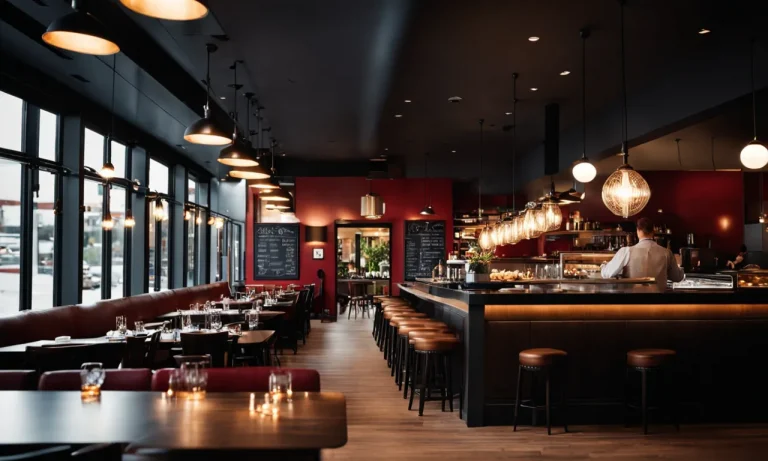Opening and running a restaurant can be an exciting yet risky venture. With high rents, food costs, staffing and other expenses, profit margins in the restaurant industry are notoriously thin. This is why many restaurateurs look to outside investors to help get their concepts off the ground.
But how exactly do these investors make money from restaurants?
If you’re short on time, here’s a quick answer to your question: Restaurant investors earn returns through revenue share, dividends, sale of equity, capital appreciation, or a combination of these methods.
In this comprehensive guide, we’ll take a deep dive into the various ways restaurant investors can profit from backing a new or existing food establishment. Read on to learn about the most common investor payment structures, the risks and rewards, and tips for negotiating a mutually beneficial deal.
Revenue Share/Royalties
When it comes to how restaurant investors get paid, revenue share or royalties are a common method used in the industry. This model involves investors receiving a percentage of the restaurant’s revenue as their return on investment. Let’s take a closer look at how this works.
Overview of revenue share models
Revenue share models typically involve investors receiving a percentage of the restaurant’s gross sales or net profits. The specific terms of the agreement can vary, but the general idea is that investors will earn a portion of the revenue generated by the business.
For example, let’s say an investor agrees to a revenue share of 10%. If the restaurant generates $100,000 in sales, the investor would receive $10,000 as their share of the revenue. This can be a mutually beneficial arrangement, as it aligns the interests of the investor with the success of the restaurant.
Pros and cons of revenue share for investors
There are several advantages to revenue share for investors. Firstly, it allows them to potentially earn a higher return on investment if the restaurant performs well. Additionally, because investors are directly tied to the revenue generated by the business, they have an incentive to actively support and promote the restaurant’s success.
However, there are also some drawbacks to consider. One potential disadvantage is that the investor’s return is dependent on the restaurant’s performance. If the restaurant struggles or fails to generate sufficient revenue, the investor may not receive a significant return on their investment.
Additionally, revenue share models can be more complex to structure and manage compared to other payment methods.
Typical revenue share percentages
The specific percentage of revenue that investors receive can vary depending on the individual agreement. However, it is common for revenue share percentages to range from 5% to 20%. The percentage is typically negotiated based on factors such as the investor’s level of involvement, the restaurant’s potential for success, and market conditions.
It’s worth noting that revenue share percentages can be adjusted over time. For example, an investor may receive a higher percentage in the early stages of the restaurant’s operation to compensate for the higher risk involved.
As the restaurant becomes more established and profitable, the percentage may be reduced.
For more detailed information on revenue share models and their implications for restaurant investors, you can refer to reputable sources such as www.restaurant.org or www.investopedia.com.
Dividends
When it comes to restaurant investments, one of the key ways that investors can see a return on their investment is through dividends. Dividends are payments made by a company to its shareholders, typically as a distribution of profits.
Let’s take a closer look at how dividends work for restaurant investors.
How dividends work for restaurant investors
When a restaurant generates profits, it may choose to distribute a portion of those profits to its investors in the form of dividends. These dividends can be paid out regularly, such as on a quarterly or yearly basis, or they can be paid out as a one-time special dividend.
The amount of the dividend can vary depending on factors such as the restaurant’s financial performance and its dividend policy.
Investors who hold shares in the restaurant are eligible to receive dividends based on the number of shares they own. For example, if an investor owns 100 shares and the restaurant declares a dividend of $1 per share, the investor would receive a dividend payment of $100.
Types of dividends investors may receive
There are different types of dividends that restaurant investors may receive. The most common type is a cash dividend, where investors receive a cash payment. Another type is a stock dividend, where investors receive additional shares of stock instead of cash.
This can be advantageous for investors as it allows them to increase their ownership stake in the restaurant without having to invest additional capital.
Additionally, some restaurants may offer a dividend reinvestment plan (DRIP), which allows investors to reinvest their dividend payments back into the company by purchasing additional shares. This can be a great way for investors to compound their returns over time.
Important considerations around dividend payouts
While dividends can be an attractive feature for restaurant investors, there are some important considerations to keep in mind. Firstly, not all restaurants pay dividends. Some may choose to reinvest their profits back into the business for growth or expansion instead.
Secondly, dividend payments are not guaranteed. The restaurant’s financial performance and cash flow can impact its ability to pay dividends consistently. Lastly, investors should also consider the tax implications of receiving dividends, as they may be subject to taxation.
It’s important for investors to carefully evaluate a restaurant’s dividend policy and financial health before making investment decisions. By understanding how dividends work and considering the various types and considerations, investors can make informed choices to maximize their returns in the restaurant industry.
Sale of Equity
When it comes to restaurant investments, one of the ways investors get paid is through the sale of equity. This means that investors can profit from selling their ownership stake in the restaurant. There are several ways in which investors can benefit from this type of payout.
Ways investors can profit from selling their equity stake
Investors can profit from the sale of equity in a restaurant in a few different ways. One common method is through a capital appreciation. If the value of the restaurant increases over time, investors can sell their equity at a higher price than what they initially paid for it.
This allows them to make a profit on their investment.
Another way investors can profit is through dividends. Some restaurants may choose to distribute a portion of their profits to their investors on a regular basis. This can provide investors with a steady income stream while they still hold their equity stake.
When the investors decide to sell their equity, they may also receive a portion of the restaurant’s profits through dividends.
Additionally, investors can also profit from the sale of equity by receiving a portion of the proceeds if the restaurant is sold to another buyer. This can happen if the restaurant is acquired by a larger chain or if the owners decide to sell the business.
In this scenario, investors may receive a payout based on the valuation of the restaurant at the time of the sale.
Valuing the restaurant business for sale of equity
Valuing a restaurant business for the sale of equity can be a complex process. It often involves considering factors such as the restaurant’s revenue, profitability, growth potential, competition, and market conditions.
Investors and restaurant owners may work with financial advisors or use industry benchmarks to help determine a fair value for the business.
Some common methods used to value a restaurant for the sale of equity include the earnings multiple approach, where the restaurant’s earnings are multiplied by a certain factor, and the discounted cash flow approach, where the restaurant’s future cash flows are discounted to their present value.
Tips for timing and negotiating equity sale
Timing and negotiating the sale of equity in a restaurant is crucial for investors to maximize their returns. It’s important to keep an eye on market trends and the overall performance of the restaurant industry.
Selling equity when the market is favorable and the restaurant is experiencing growth can result in a higher sale price.
When negotiating the sale of equity, investors should consider factors such as the financial health of the restaurant, its competitive position, and potential future growth. It’s also important to have a clear understanding of the terms and conditions of the sale, including any restrictions on the use of proceeds and potential tax implications.
Capital Appreciation
Restaurant investors, like any other type of investor, aim to make a profit on their investment. One way they can achieve this is through capital appreciation. This refers to the increase in the value of the restaurant over time.
How restaurant valuation impacts investor returns
The valuation of a restaurant plays a crucial role in determining the investor returns. A higher valuation means that the restaurant is worth more, and therefore, investors can expect a higher return on their investment. On the other hand, a lower valuation may result in lower returns.
There are several factors that can impact the valuation of a restaurant, including its location, reputation, customer base, revenue, and profitability. Investors carefully analyze these factors before deciding to invest in a restaurant, as they directly impact the potential for capital appreciation.
Strategies for increasing restaurant value over time
Restaurant owners and investors employ various strategies to increase the value of a restaurant over time. These strategies include:
- Improving the menu: Offering innovative and high-quality dishes can attract more customers and increase the restaurant’s revenue.
- Enhancing the customer experience: Investing in better customer service, ambience, and amenities can help create a positive dining experience and build customer loyalty.
- Expanding the business: Opening new locations or franchising the restaurant can lead to increased revenue and a higher valuation.
- Implementing cost-saving measures: Managing expenses effectively can improve profit margins, making the restaurant more attractive to investors.
By implementing these strategies, restaurant owners can increase the value of their establishment, providing investors with the potential for higher returns.
Understanding capital gains taxes
When restaurant investors sell their shares or ownership stake in a restaurant, they may be subject to capital gains taxes. These taxes are levied on the profit made from the sale of the investment.
The specific tax rate and regulations surrounding capital gains taxes vary by country and jurisdiction. It is important for investors to consult with a tax professional or accountant to understand their tax obligations and plan accordingly.
Investors may also consider strategies such as tax deferral or investing in tax-advantaged accounts to minimize the impact of capital gains taxes on their investment returns.
For more information on capital gains taxes and how they may affect restaurant investors, you can visit https://www.irs.gov/taxtopics/tc409.
Hybrid Payment Structures
When it comes to restaurant investments, a hybrid payment structure is often employed to ensure that both the investor and the restaurant owner benefit from the partnership. This structure typically combines various payment methods such as revenue share, dividends, and equity sale, among others.
Combining revenue share, dividends, equity sale, etc.
One common approach in hybrid payment structures is to incorporate revenue sharing. This means that the investor receives a percentage of the restaurant’s revenue in return for their investment. This can be a win-win situation as it allows the investor to directly benefit from the restaurant’s success.
Additionally, dividends may also be included in the payment structure, allowing investors to receive a portion of the restaurant’s profits.
Another element that can be included in a hybrid payment structure is the sale of equity. This means that the investor has the opportunity to sell their ownership stake in the restaurant at a later date, potentially reaping a significant return on their initial investment.
By combining these different payment methods, restaurant investors can diversify their income streams and mitigate risk.
Tailoring payment terms to suit both parties
The beauty of hybrid payment structures is that they can be customized to suit the needs and preferences of both the investor and the restaurant owner. This flexibility allows for negotiations that take into account the specific circumstances of the business.
For example, if the restaurant is facing financial challenges, the payment terms can be adjusted to provide more immediate financial support to the owner. On the other hand, if the restaurant is thriving, the payment structure can be modified to allow the investor to reap greater rewards.
Being flexible to changing business conditions
One of the advantages of hybrid payment structures is their ability to adapt to changing business conditions. This is particularly important in the restaurant industry, where factors such as seasonality, economic fluctuations, and unforeseen events can greatly impact a restaurant’s profitability.
By having a hybrid payment structure in place, both the investor and the restaurant owner can navigate these challenges more effectively. For example, if the restaurant experiences a temporary downturn, the investor may be willing to adjust their payment terms to provide some relief.
This flexibility helps to foster a stronger partnership between the investor and the restaurant owner.
Key Terms and Considerations
When it comes to restaurant investments, there are several key terms and considerations that investors need to be aware of. These factors can greatly impact how and when investors get paid. Let’s take a closer look at some of these important aspects:
Defining clear payment timelines upfront
One of the first considerations for restaurant investors is to define clear payment timelines upfront. This involves determining when and how investors will receive their returns on investment. It’s important for both parties to have a clear understanding of when payments will be made, whether it’s through regular distributions or a lump sum payment at the end of a specified period.
The implications of equity percentages
Equity percentages play a significant role in how restaurant investors get paid. Investors who hold a higher percentage of equity in the restaurant will typically have a greater say in how profits are distributed.
It’s important for investors to carefully consider the equity structure and negotiate a fair percentage that aligns with their investment goals and expectations.
Accounting for risk vs. return
Investing in the restaurant industry comes with its fair share of risks. It’s crucial for investors to carefully assess and account for these risks when determining how they will be compensated. Higher-risk investments may warrant higher returns, while lower-risk investments may result in more modest payouts.
It’s essential for investors to strike a balance between risk and return to ensure they are adequately compensated for their investment.
Exit strategy options
Having a clear exit strategy is vital for both restaurant owners and investors. Investors should consider the various exit options available to them, such as selling their equity stake, receiving a buyout offer, or taking the company public.
Each exit strategy comes with its own set of implications for how investors will be paid. It’s important for investors to understand their options and work with the restaurant owner to determine the best course of action.
By considering these key terms and factors, restaurant investors can better understand how they will be paid and make informed decisions about their investments. It’s crucial to have open and transparent communication between all parties involved to ensure a mutually beneficial arrangement.
Conclusion
Attracting the right investors lays a solid foundation for any restaurant to thrive. Understanding the various ways investors earn returns from a food business helps set realistic expectations. With open communication and clearly defined payment structures, restaurateurs and investors can build symbiotic partnerships where both stand to profit.
This outlines the key methods restaurant investors get paid, along with factors to weigh on both sides. Armed with this knowledge, you can negotiate win-win financial terms and align on shared goals for your restaurant’s success.






